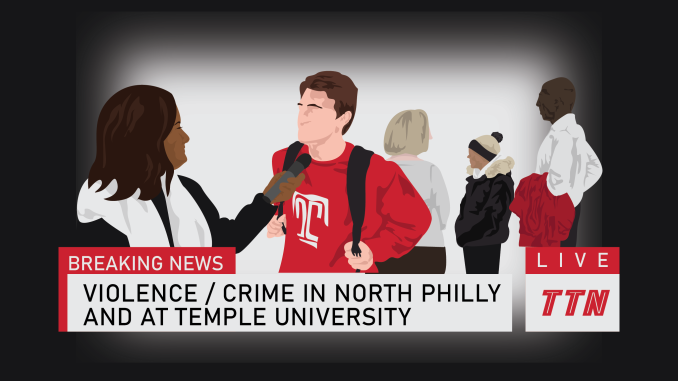
Last December, a group of researchers, including Jessica Beard, a Temple University trauma surgeon and director of research at the Philadelphia Center for Gun Violence Reporting, published a study detailing the effects of episodic gun violence reporting, which frames gun violence as individual shooting events rather than a larger public health issue.
The gun violence study was among the first in more than 20 years due to a congressional ban on the Centers for Disease Control and Prevention funding research on guns because lawmakers viewed it as funding gun control.
The study found episodic journalism excludes the victim’s side of the story, often contains misinformation, leads victims to relive trauma, causes threats to personal safety and dehumanizes victims as faceless numbers. It leaves survivors feeling like they’re “a nobody.”
In response to the PCGVR study, and any future research, news organizations must adjust their coverage of gun violence by ensuring all crime reporters employ trauma-informed reporting and tell stories from perspectives beyond the police. Additionally, larger stories should be dedicated to deeper reporting about the systemic reasons for and the effects of gun violence, not just when shootings happen.
Breaking news should not take priority over victims’ trauma.
Although some may argue episodic crime reporting keeps the public informed about local crime in a timely manner, only nearly half of the shootings in Philadelphia actually get coverage, Beard said. If half of all shootings aren’t reported on, then the public is already unaware of every crime happening nearby.
Philadelphia may have an uphill battle as the birthplace of Eyewitness News and Action News, but these genres have been critiqued as harmful reporting that spread false narratives about Black communities, Beard said.
“On the flip side, it’s not something that should be so entrenched in our work that we can’t propose and enact alternative narratives that will be more helpful,” she said.
Trauma-informed reporting tells a more humanized story of gun violence. It recognizes the experiences of the person being interviewed, how those experiences could affect them currently and how the interview process could add to their trauma. Still, this reporting doesn’t reduce a person to their trauma, according to Nieman Reports.
News organizations should annually train journalists who cover crime beats in trauma-informed reporting and encourage them to consciously practice it in the field.
This ethical reporting would include reaching out to victims and co-victims of gun violence and giving them adequate time to respond before publishing stories that reduce them to “nobodies.” This would help journalists gather a fairer perspective of what happened at a crime scene.
If a victim or co-victim is not ready or able to speak to reporters, journalists should reach out to community advocates and make sure their coverage of gun violence isn’t dehumanizing.
“One of the things that I think too many journalists operate under is that we forget that there are faces behind the statistics and what I mean by that is, there’s stories there,” said Linn Washington Jr., a journalism professor.
Journalists should rethink who the narrator is in a story about community gun violence. When the police are the most common authoritative voice in news reports about crime, it takes media attention away from victim and community advocate voices who could offer more personally informed perspectives about systemic connections to gun violence, like race and redlining.
“The police are put forward by the media as the solution as opposed to calling for reparations for the African community for the billions that has been spent on police to contain the Black community as well as the communities, the housing and other resources that have been eaten up by this corporation that is known as Temple,” said Diop Olugbala, an East Germantown resident and Black Community Control of Police activist.
Historically redlined Philadelphia neighborhoods, like North Central, experience the highest number of homicides and are the most disadvantaged communities in the city, according to the Office of the Controller. Additionally, about 81 percent of gun violence victims in Philadelphia are Black, according to PCGVR’s Philadelphia Shooting Victims Dashboard.
As Black communities are disproportionately impacted by gun violence, episodic journalism contributes to false narratives, representing them as faceless victims and perpetrators of crimes.
“Anything that’s harmful regarding reporting on community firearm violence is going to disproportionately impact the people who are impacted by community firearm violence, which is Black people living in structurally marginalized places in our city,” Beard said.
To lessen the impact of episodic reporting, journalists must understand and report on community gun violence as a whole, rather than individual incidents. Stories should search for solutions and dig deeper into the root causes and effects of gun violence as a public health issue.
Deeper, consistent and more probative coverage of the effects of gun violence could mitigate some of the concerns about victims’ pain not being covered, Washington said.
As more research on gun violence and the media is published, PCGVR is currently planning to investigate the relationship between the amount of media coverage and the frequency of gun violence, Beard said.
“We’re all in it together to try to make things better and really rethinking structures and approaches that may not be person-centered and that could be perpetrating harmful and racist narratives is really the call of this generation,” Beard said.



Be the first to comment